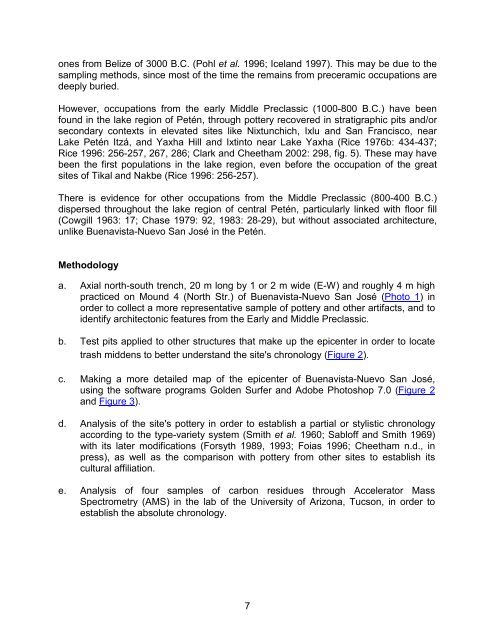Buenavista-Nuevo San José, Petén, Guatemala: Another ... - Famsi
Buenavista-Nuevo San José, Petén, Guatemala: Another ... - Famsi
Buenavista-Nuevo San José, Petén, Guatemala: Another ... - Famsi
You also want an ePaper? Increase the reach of your titles
YUMPU automatically turns print PDFs into web optimized ePapers that Google loves.
ones from Belize of 3000 B.C. (Pohl et al. 1996; Iceland 1997). This may be due to the<br />
sampling methods, since most of the time the remains from preceramic occupations are<br />
deeply buried.<br />
However, occupations from the early Middle Preclassic (1000-800 B.C.) have been<br />
found in the lake region of <strong>Petén</strong>, through pottery recovered in stratigraphic pits and/or<br />
secondary contexts in elevated sites like Nixtunchich, Ixlu and <strong>San</strong> Francisco, near<br />
Lake <strong>Petén</strong> Itzá, and Yaxha Hill and Ixtinto near Lake Yaxha (Rice 1976b: 434-437;<br />
Rice 1996: 256-257, 267, 286; Clark and Cheetham 2002: 298, fig. 5). These may have<br />
been the first populations in the lake region, even before the occupation of the great<br />
sites of Tikal and Nakbe (Rice 1996: 256-257).<br />
There is evidence for other occupations from the Middle Preclassic (800-400 B.C.)<br />
dispersed throughout the lake region of central <strong>Petén</strong>, particularly linked with floor fill<br />
(Cowgill 1963: 17; Chase 1979: 92, 1983: 28-29), but without associated architecture,<br />
unlike <strong>Buenavista</strong>-<strong>Nuevo</strong> <strong>San</strong> <strong>José</strong> in the <strong>Petén</strong>.<br />
Methodology<br />
a. Axial north-south trench, 20 m long by 1 or 2 m wide (E-W) and roughly 4 m high<br />
practiced on Mound 4 (North Str.) of <strong>Buenavista</strong>-<strong>Nuevo</strong> <strong>San</strong> <strong>José</strong> (Photo 1) in<br />
order to collect a more representative sample of pottery and other artifacts, and to<br />
identify architectonic features from the Early and Middle Preclassic.<br />
b. Test pits applied to other structures that make up the epicenter in order to locate<br />
trash middens to better understand the site's chronology (Figure 2).<br />
c. Making a more detailed map of the epicenter of <strong>Buenavista</strong>-<strong>Nuevo</strong> <strong>San</strong> <strong>José</strong>,<br />
using the software programs Golden Surfer and Adobe Photoshop 7.0 (Figure 2<br />
and Figure 3).<br />
d. Analysis of the site's pottery in order to establish a partial or stylistic chronology<br />
according to the type-variety system (Smith et al. 1960; Sabloff and Smith 1969)<br />
with its later modifications (Forsyth 1989, 1993; Foias 1996; Cheetham n.d., in<br />
press), as well as the comparison with pottery from other sites to establish its<br />
cultural affiliation.<br />
e. Analysis of four samples of carbon residues through Accelerator Mass<br />
Spectrometry (AMS) in the lab of the University of Arizona, Tucson, in order to<br />
establish the absolute chronology.<br />
7
















